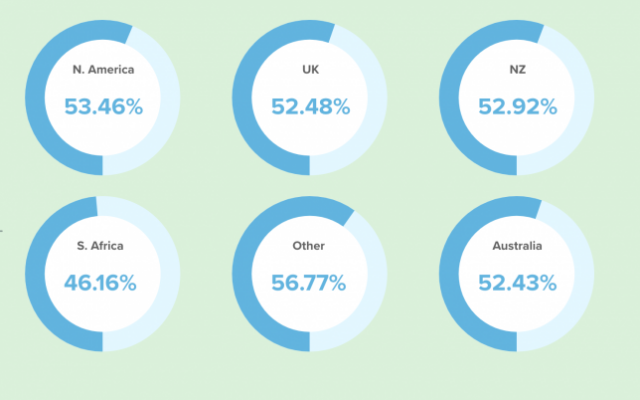
Owning and operating your own retail business boils down to profits.
Retail may just be what you’re good at, it may be the family business, or it may be your passion but in the end, you need to turn a profit to live a good life.
So, now you are probably wondering what your profit margins should be at your retail store. Depending on what you know about retail and profit margins, it may not surprise you to learn that there are different types of profit margins. That said, it would be careless to just throw out a number at this point.
First, let’s take a look at the different profit margins in the retail industry.
Gross Profit Margins in Retail
Your gross profit margins are your total sales less your COGS (cost of goods sold). Your company’s COGS count as an expense on your balance sheet and they affect your profit margins. Let’s look at an example.
If you determine your COGS are $150,000 annually and your total sales are $300,000 for the year, then your gross profit margins are $150,000. That number is good to know but most retailers refer to profit margins as a percentage.
So if you take your COGS, which are $150,000, and divide them by your annual sales, which are $300,000 you’ll get your percentage. Your gross profit margins are about 50 percent for the year. This is just an example, of course.
Average Gross Profit Margins for Retailers

Gross profit margins will be different across retailers because there are multiple types of retail businesses. The average gross profit margins for all retail industries range from about 35 percent all the way up to 65 percent, depending on the type of business. Retailers with the highest gross profit margins included:
- Women’s Cosmetics
- Drink Manufacturers
- Jewelers
According to studies conducted in 2019, retailers with the lowest gross profit margins included:
- Stores selling drinks with alcohol
- Sports equipment and memorabilia
- Stores selling technology or electronics
Across the board, with all retail types included, the average gross profit margins were about 53 percent. While your retail business may be a little different, it still helps to see how your business compares to other retailers when it comes to your gross profit margins.
The gross profit margins are only one of the profitability ratios that show how well your company uses the materials it has to produce the items you’re selling. Your gross profit margins are also good for tracking and predicting future renewability.
Net Profit Margins in Retail

Net profit margins in retail paint a different picture. They are much smaller than the gross profit margins because they reflect dollar amounts and percentages after all expenses have been paid. To calculate your net profit margins you’ll divide your retail net income by your revenue. This means the COGS, operating expenses, taxes, and interest have all been subtracted.
Though the numbers for retail net profit margins are smaller, they do paint a clearer picture of profitability because they reflect how much of every $1 is kept after all operating expenses have been paid. Average net profit margins in the retail industry range from 0.5% to 3.5% with the entire retail industry averaging 3.2% across the board.
Some of the highest net profit margins included the banking industry with an average of 24% and home improvement stores averaging around 8% net profit margins. The transportation industry and automobile sales are typically on the lower end of retail profit margins.
Increasing Net Profit Margins
While net profit margins can be different across multiple retail industries, businesses often try to get a leg up by increasing net profit margins. The best way to do this is by increasing revenue or reducing operating expenses. Some businesses try to do both which means they get to keep more of each $1 made throughout the year.
Increasing net profit margins can be a little tricky because it often takes an increase in expenses to boost revenue. One way to reduce operating expenses is to go through each system and make changes to increase efficiency in operations.
Sometimes even introducing technology into areas and systems where human error can be removed can make a big difference in future bottom lines but will require an initial investment which temporarily increases operating expenses.
Careful Considerations

Some retail businesses must approach this idea carefully because they must remain elastic due to changes in consumer demand. Businesses dealing in retail apparel are one example.
Consumer tastes change quickly according to what’s on trend and there are so many competitors due to global internet access. Access to so many other retailers lets consumers price compare across channels giving retail apparel companies yet another consideration when trying to increase revenue.
Retail businesses attempting to reduce operating expenses must carefully consider the cost of any potential changes. Unfortunately, decisions made too quickly may lead to reduced quality products or services which will directly impact revenue in a negative manner. Sometimes companies can lose well-trained labor or end up using mediocre materials in trying to reduce production costs. It is a slippery slope.
Profit Margins Recap
Just to recap, gross retail profit margins are equal to total sales less your COGS. While it is a helpful predictor of future remuneration, it is not completely reliable as it does not take into account any operating expenses, taxes, etcetera. Retail net profit margins are calculated by dividing retail net income by revenue after all expenses have been accounted for.
Retail net profit margins are smaller than gross profit margins but together they can be a reliable predictor of future remuneration. Depending on the retail industry, elasticity may be necessary because of shifting consumer demand.
Reducing operating expenses or increasing revenue can increase the net profit margins at the end of a period but retailers must be careful of producing mediocre products or services. Sometimes the best option is to expand which requires a temporary increase in operating expenses.
Determining the Best Profit Margin for Your Retail Store
Determining the best profit margin for your retail store depends on the specific industry you’re operating. It also helps to compare your gross profit margins and your net profit margins against others in the same industry.
When it’s time to increase net profit margins, don’t do it at the expense of the products or services you offer. You may need to expand your business to get it done.












